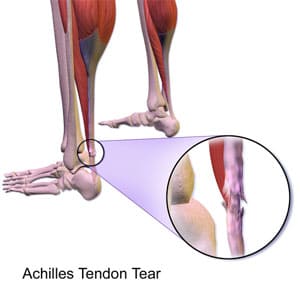Achilles Tendinitis
Achilles Tendinitis Symptoms, Causes and Treatment
What Is Achilles Tendinitis?
Achilles tendinitis is an injury to the Achilles tendon, the tissue that connects the heel bone to the calf muscles. Sometimes spelled tendonitis, it is a relatively common injury, typically caused by overuse. The condition is most common in people who suddenly increase their levels of physical activity. This includes people new to exercise as well as experienced runners who increase the speed or duration of their workouts.
It can be caused by overuse, repetitive strain, or injury. Symptoms of Achilles tendinitis include pain, swelling, and stiffness in the back of the ankle, especially during physical activity. Risk factors for Achilles tendinitis include sports activities that involve running or jumping, improper footwear, and flat feet.

Types of Achilles Tendinitis
There are two types of Achilles tendinitis. Insertional tendinitis occurs where the tendon attaches to the heel bone. Noninsertional tendinitis occurs toward the middle of the tendon and is more common in younger people.

What Are the Symptoms of Achilles Tendinitis?
The most common symptom of Achilles tendinitis is a mild, aching pain at the back of the leg, between the calf and heel. Typically, pain is worse after exercise and may be more severe after prolonged or unusually strenuous activity.
In addition, the affected area may feel stiff, particularly when first putting weight on the foot. Unlike the pain, this symptom usually improves with movement.
If you experience sudden, sharp pain at the Achilles tendon, it may have torn or ruptured. You may also have noticed a distinct “popping” sound. If this happens, seek immediate medical treatment.
What Causes Achilles Tendinitis?
Achilles tendinitis is most often caused by repeated strain on the tendon that connects your foot to your calf muscles. Every time you walk, run, or otherwise move your feet, you use your Achilles tendon.
Like many conditions, your risk of Achilles tendinitis increases with age. This is because the tendon weakens over time, increasing the risk of injury. This is especially true if you lead a mostly sedentary lifestyle and only engage in physical activity once or twice a week.
You’re also at greater risk if you:
- Are male
- Are overweight
- Have flat feet or low arches
- Have high blood pressure
- Run in cold weather or on uneven terrain
- Take a medication called fluoroquinolone, a type of antibiotic
- Wear shoes that are worn out or not meant for your activity
Tendinitis increases your risk of tendon rupture.
How to Reduce Your Risk of Achilles Tendinitis
There is no 100 percent guaranteed method that protects you from developing tendinitis. However, you can reduce your risk by following these tips.
- Increase activity duration and intensity levels over time
- Wear quality shoes that provide excellent arch support and ample cushioning
- Replace your shoes after every 300-500 miles of running or walking
- Stretch your Achilles tendon every morning as well as before and after exercise
- Always warm up before performing strenuous activities
- Avoid running on uneven terrain, which places excess strain on the tendon
- In addition to running and walking, incorporate non-weight-bearing activities like swimming and cycling
- Add strength training exercises to your workout, particularly those that work the calf muscles
Before beginning any exercise program, talk to your doctor.
Diagnosing Achilles Tendinitis
After taking your medical history, your podiatrist performs a physical examination of the affected area. In addition to testing pain, swelling, and tenderness, he or she looks at your foot and ankle’s range of motion, flexibility, and alignment.
Your doctor may also order diagnostic imaging. This may include x-rays, ultrasound, and/or MRI. These tests help rule out other causes of your pain.
Achilles Tendinitis Treatment
Typically, rest and self-care are just what the doctor ordered. Your doctor may also suggest over-the-counter pain medications, particularly ibuprofen, to reduce inflammation.
If your symptoms persist, your doctor may recommend physical therapy exercises that stretch and strengthen the tendon and surrounding tissues. Finally, orthotics may be prescribed to reduce pressure on the heel, which relieves strain on the Achilles tendon.
Achilles Tendinitis Surgery
We typically pursue conservative treatment for 6 months. However, if conservative treatment does not work, your provider may recommend surgery to treat your Achilles tendinitis. The type of surgery performed depends on numerous factors, such as whether you have insertional or noninsertional tendinitis.
If you have pain in the heel or ankle, schedule an appointment with Preferred Foot & Ankle today.
All Foot & Ankle Conditions We Treat
Advanced Foot & Ankle Solutions
Have Questions or Need Care?
We’re here to help! Schedule your appointment online now for fast and easy care.
